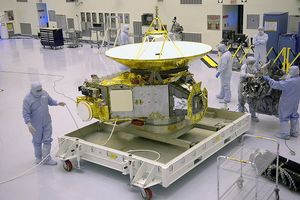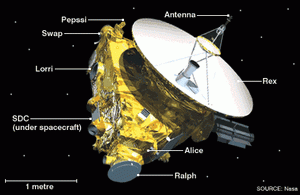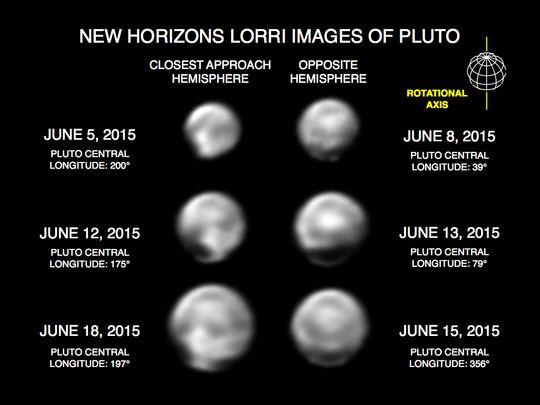After 9 years and billions of miles travelling, NASA’s New Horizons probe finally reaches Pluto in July. The mission goal is to understand the formation of the Pluto system, the Kuiper Belt, and the transformation of the early Solar System. The spacecraft will study the atmospheres, surfaces, interiors and environments of Pluto and its plethora of moons. It will also study other objects in the Kuiper Belt depending on which are in position to be explored.
 The spacecraft is comparable in size and general shape to a grand piano and has been compared to a piano glued to a cocktail bar-sized satellite dish.
The spacecraft is comparable in size and general shape to a grand piano and has been compared to a piano glued to a cocktail bar-sized satellite dish.
The overall cost of the mission is approximately $650 million over 15 years (2001–2016)
After several delays, New Horizons was launched on January 19, 2006, from Cape Canaveral, directly into an Earth-and-solar-escape trajectory. Because of the need to conserve fuel for possible encounters with Kuiper belt objects subsequent to the Pluto flyby, intentional encounters with objects in the asteroid belt were not planned. However, the New Horizons project team determined that by chance New Horizons would pass close to the tiny asteroid on June 13, 2006, close enough for detailed observations. The asteroid was estimated to be 2.5 km (1.6 miles) in diameter. Closest approach was 101,867 km (63,297 miles)
 New Horizons then proceeded to Jupiter, making its closest approach on February 28, 2007 at a distance of 2.3 million kilometers (1.4 million miles). The planned Jupiter flyby provided a gravity assist that increased New Horizons 'speed 14,000 km/h; 9,000 mph to 83,000 km/h; 51,000 mph; shortening its voyage to Pluto by three years. Horizons crossed the orbit of Saturn on June 8, 2008, and Uranus on March 18, 201. Most of the post-Jupiter voyage was spent in hibernation mode to preserve on-board systems. On December 6, 2014, New Horizons was brought back on-line for the encounter, and instrument check-out began.
New Horizons then proceeded to Jupiter, making its closest approach on February 28, 2007 at a distance of 2.3 million kilometers (1.4 million miles). The planned Jupiter flyby provided a gravity assist that increased New Horizons 'speed 14,000 km/h; 9,000 mph to 83,000 km/h; 51,000 mph; shortening its voyage to Pluto by three years. Horizons crossed the orbit of Saturn on June 8, 2008, and Uranus on March 18, 201. Most of the post-Jupiter voyage was spent in hibernation mode to preserve on-board systems. On December 6, 2014, New Horizons was brought back on-line for the encounter, and instrument check-out began.
In January 2015, the New Horizons spacecraft began its approach phase to Pluto. Mission navigators are now attempting to position the probe; an imaginary rectangle in space measuring just 100 by 150 kilometres in order to ensure that the spacecraft can make all planned science observations during its fly-by of Pluto The last chance to change the spacecraft’s flight path comes on 4 July. When New Horizon’s slips by Pluto at 14km/sec it will need to quickly rotate its instruments to look at the surface. It will then continue on a precise path into the shadows of both Pluto and Charon, for its sole chance to look back and explore atmospheres on those worlds. The situation is so complex that New Horizons has, unusually, two navigation teams, and will choose the best option if their trajectory strategies are not consistent with one another. The whole thing is fraught with danger and will require precision and a slice of luck.

Approximately over 30 million km distant, New Horizons is already sending back tantalising images of Pluto and its chief moon Charon. These show mysterious bight and dark patches on Pluto and what appears to be a very dark polar cap on Charon, indicating a wide range of landscapes.
So, hold on to your hats, strap yourself in and keep everything crossed, it will undoubtedly be a very tense occasion, but hopefully a truly historic one.
You will be able to follow the mission via the Nasa web site, (and probably numerous others), it is also likely to feature widely across the media.
Mission break down
New Horizons’ fly-by of Pluto happens on July 14, 2015 at 11:50 UT, all of the most important goals for the mission occur in a 3 hour window, but it will not finish returning all of the data until late 2016.
The Pluto mission is divided into several phases:
- Approach Phase 1: 180 to 100 days before closest approach (Jan 6-Apr 4; range to Pluto is 226-121 million km). SWAP and PEPSSI will measure plasma. LORRI will monitor motions of Pluto, Charon, and the smaller moons. Pluto is barely resolved.
- Approach Phase 2: 100 to 21 days before closest approach (Apr 4-Jun 23; range to Pluto is 121-26 million km). Add in colour observations, and search for satellites and rings. The start of this phase is chosen to roughly coincide with the time when LORRI has better resolution than Hubble, but Pluto will still be only a few pixels across.
- Approach Phase 3: 21 to 1 days before closest approach (Jun 23-Jul 13; range to Pluto is 26-1.2 million km). Includes best, second-best, and third-best rotation coverage before closest approach, yielding the best global maps of Pluto and Charon. PEPSSI and SWAP may detect pickup ions and bow shock. LEISA and Alice can begin looking for variability in IR and UV. Search for clouds or hazes, tracking winds.
- Near Encounter Phase: -1 to +1 days (Jul 13-15, within 1.2 million km) — sequenced in 2008 and 2009. Most of the highest-priority observations.
- Departure Phase 1: 1 to 21 days after closest approach (Jul 15-Aug 4; range to Pluto is 1.2 to 24 million km). Remote sensing of Pluto and Charon is performed for only 1 rotation. SWAP and PEPSSI study magnetotail, pickup ions. REX studies night side temperatures. Nix and Hydra high-phase observations. Search for rings.
- Departure Phase 2: 21 to 100 days after closest approach (Aug 5-Oct 22; range to Pluto is 24 to 119 million km).
- Departure Phase 3: 100 to 180 days after (Oct 22-Jan 1, 2016; range to Pluto is 119 to 203 million km). No remote sensing observations planned.
Once it’s finished here, New Horizon will visit one or more Kuiper Belt Objects beyond Pluto.
Image Credits: NASA
- Log in to post comments
